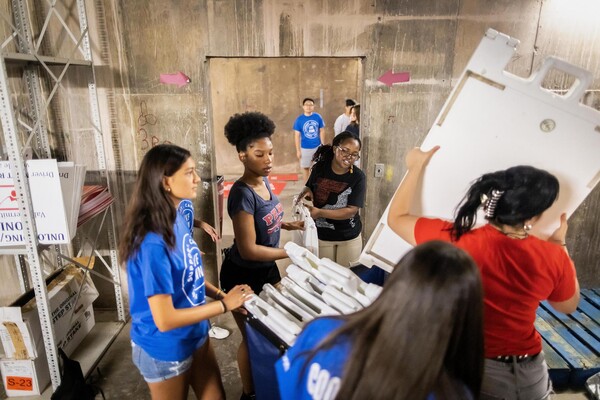Jon Ang
Jon Ang (W’97) started out a typical Wharton student, moving from securities classes to summer internships to an entry-level analyst position at a New York financial firm.
But something was missing. He’d done community service since high school, and the fast-paced, demanding world of investment banking left him no time for the activities he calls “giving back.”
He thought he’d take some time off to regain perspective, maybe build a house or teach. In his search for a philanthropic project, he instead found a new job, as a research analyst at the Boston-based Initiative for a Competitive Inner City (ICIC), and from that came a new career path — marshalling the forces of business and commerce to revitalize America’s impoverished inner cities.
Last month, Ang was awarded a Luce Scholarship, making him one of only six Americans awarded this year-long grant to work in Asia and gain familiarity with Asian affairs.
He doesn’t know exactly where the program will send him, but he looks forward to immersing himself in a new culture and hopes to study how business affects urban development in a developing country with a market-based economy.
Q. What are you most looking forward to about your year abroad?
A. I’m very much looking forward to the challenges of a new environment and new culture. I’m really interested in getting the Asian experience, so I’m not going to live in an expat community. I’m going to try to immerse myself in the local culture. I guess at times that’s going to get lonely, but I’m looking forward to those types of experiences where you grow and learn to overcome.
Professionally, it’s a huge opportunity to learn about the topic of urban poverty from a new setting. What I’m trying to do is take the intersection of business and urban issues that I’ve done here and apply that to Asia. Asia faces an immense amount of urban poverty. It’s not the same as the United States, where people used to live in the inner city and fled for different reasons. In Asia, everyone is flooding into urban areas because that’s where the opportunities are.
Q. Why did you leave investment banking to work in the nonprofit sector?
A. Investment banking was great but, as a 22-year-old, it wasn’t getting me out of bed. It wasn’t an inspiring career. You don’t want to feel that way when you’re just starting to get on your toes, like the pay is great but it’s kind of a drag.
Originally I wanted to take some time out and say, Okay, I want to give back and this is a great time to do it, I’m not really wedded to this particular area yet.
Then I took this job. The unique thing about ICIC is it’s the best leverage of my experience and my education. It’s been a fascinating field for me to learn more about — and concentrate my professional effort around.
Q. What is, or should be, business’ role in inner-city revitalization?
A. The way that we like to advocate the role that business can play is that if you create businesses that make sense, that derive an advantage from being in an inner-city location, you’re able to create a sustainable enterprise in the inner city, thereby creating jobs, income and wealth for inner-city residents.
A lot of the work I do is around inner-city retailing. By inner city we mean the distressed areas, areas with poverty, unemployment and a lower standard of living in general. There’s a huge number of people being deprived of retailing.
So we try to educate the retailers, like the Gap, Wal-Mart, Pathmark, on the advantage and the actual profit that they can make by locating in an inner-city area. Many retailers view the inner city as dangerous, unsafe, as an area of distress. We try to flip their perception on its head and say, Granted, there are those types of things that exist in inner-city
areas, but there’s a huge amount of population density, so there’s a huge income that can be tapped. There’s a huge supply-demand imbalance. At the Walnut Street Thriftway on a Saturday afternoon, the lines are like out the door. Obviously people are spending money there, but retailers have a mental block.
I also spend a lot of time understanding the inner-city shopper. We partner with PricewaterhouseCoopers to do a survey every year of 1,200 inner-city shoppers across the country. Then we can tell retailers, There’s this huge market, but you need to offer what they want. That may mean more ethnic goods, more pre-cooked goods, things like that.
Some people say that the people who are benefiting are Pathmark, not the community itself. But you’re providing an incredible service to an inner-city community, because instead of paying $5 for a gallon of milk at a bodega, where it’s probably been sitting there for a couple of days already, you’re providing them with fresher produce at a better price and a world-class shopping environment.
Beyond that, retailing creates a lot of jobs. It’s great experience for inner-city residents to gain career skills. And whether they stay at that job or not, they have one more job under their belt.
Also, just by putting that retailer there, where for the past 25 years there hasn’t been one, you’re showing the community that America cares about you. Think about the suburbs where there’s a strip mall at every corner and everyone has the latest Ziploc bag or everybody has the latest sweater from the Gap. Inner-city residents have to travel to get that kind of attention. By putting retail in the inner-city area, it speaks volumes about the social equity that exists in the United States.
Q. What’s your vision for inner-city areas?
A. I love the inner city because it’s diverse. It’s one of those double-edged swords because as inner-city areas start to prosper, the land values go up, and people who live there currently are forced to move out, and you’ve got this yuppie gentrification going on which is really frustrating.
It’s hard. You want to see the inner cities retain a sense of choice. A lot of times, people who live in these areas are deprived of the ability to decide their own fate. They’re forced to work a couple jobs. They’re forced to leave school early. If you can just see the inner city as a place where people choose to live, they choose to buy a house there, they choose as they accumulate wealth not to move out, that’s the way you’re going to revitalize it without depriving it of the sense of history and promise that makes it so unique and special.
Hopefully, as inner-city residents start to obtain jobs and businesses relocate there, you just need to educate people about home ownership. If they can purchase their homes in these areas, it makes a huge difference in their ability to stay there and it makes a difference in their ability to accumulate wealth, because as property values go up their wealth goes up also.
Q. What’s been your greatest triumph at ICIC?
A. I was at a meeting in Los Angeles in October. It was a bunch of retailers and we were talking about site selection in inner-city areas. The Gap showed a video about a store they had just opened on Fordham Road in the Bronx, and they credited ICIC with a lot of assistance in having that store come about. You could see from interviews with people in the community that they were overjoyed by having the Gap coming there.
It’s tough to leave [ICIC], actually. I’m really happy here, I’ve had a great experience and met great people, but this is one of those once-in-a-lifetime opportunities that you really can’t pass up.







